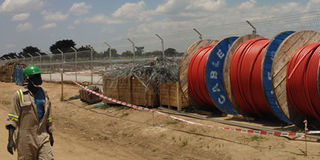Uganda imports electricity despite surplus

A man walks past electricity transmission cables. With over 1,171MW of generation capacity and only 600MW of peak demand, a report by Electricity Regulatory Authority, indicates that Uganda, through the Electricity transmission company still imports power.
FILE PHOTO
What you need to know:
Uganda currently has no alternative routes of transmission. So if her electricity system goes down, the only boost comes from Kenya, Christine Kasemiire explains.
With the water dripping power Uganda currently possesses in generation capacity and the crumble like demand from the public, she still imports electricity from Kenya.
With over 1,171MW of generation capacity and only 600MW of peak demand, a report by Electricity Regulatory Authority, (ERA) indicates that Uganda, through the Electricity transmission company still imports power.
Sometimes, Uganda has run to her neighbour Kenya for power rescue. For instance, in 2017, Uganda Electricity Transmission Company Limited, (UETCL) imported close to 40megawatts (MW) of power, in 2015, over 60MW, but about 50MW in 2016 and 71.2MW in 2018.
Uganda-Kenya
Mr William Kiryahika, managing director UETCL, says Uganda and Kenya are ‘married’ to each other through systems. He says to maintain a relationship especially in the event of a deficit or surplus in any of the two countries, the imports and exports ought to take place.
To maintain the ‘marriage,’ he said the two countries agreed to exchange 4MW but on demand, the countries exchange higher.
UETCL also explained that Uganda imports power from Kenya when the Nalubaale and Bujagali dams have broken down and need to be boosted.
“We import power when we have a fault in the line that connects to Bujagali. They help us with power to boost our system back to running,” Ms Pamela Nalwanga, communications officer UETCL, says.
She also explained that Uganda currently has no alternative routes of transmission, “so if our system goes down, the only boost comes from Kenya.”
Bujagali and Nalubaale are the focal points from which most areas in Uganda especially Kampala and Entebbe are connected.
Karuma dam
The anticipated onset of Karuma dam in December will not save much, if the necessary transmission infrastructure is not present.
Karuma, a 600MW dam cannot address the importation of power because currently, the transmission infrastructure enabling it to connect to various areas of Uganda is not present.
Currently, the dam has three evacuation lines- Karuma-Kawanda, Karuma –Lira and Karuma-Olwiyo.
Construction of those lines cost $246m (Shs920b).
While Uganda will have a surplus in electricity, Karuma cannot necessitate a ‘divorce’ from Kenya especially since a power pool is being developed to enable power trade between different countries.
Mr Kiryahika says construction of the necessary transmission pipes is ongoing. He described a pipe as a network through which power is transmitted to different areas in the country.
“Karuma when switched on, will be enough. But is the pipe arrangement available in that the power can reach every part of the country,” he ponders rhetorically.
“We are building the pipes but they are not complete. Construction is ongoing,” he added.
National grid
As at 2018, Uganda’s transmission length, otherwise known as national grid was at 2569.8km.
Energy sales
UETCL in 2018 bought 5 per cent more electricity from power generators from 3,867.1 gigawatt hours (GWh) in 2017 to 4,078.5GWh.
Most of the energy stemmed from large hydros such as Nalubaale and Bujagali, small hydros, bagasse then solar and imports.
Power distributor Umeme recorded the highest purchases from UETCL, taking over 92 per cent of the power, followed by exports which accounted for 6 per cent of the power sold and mini grids took up the remaining 2 per cent.




